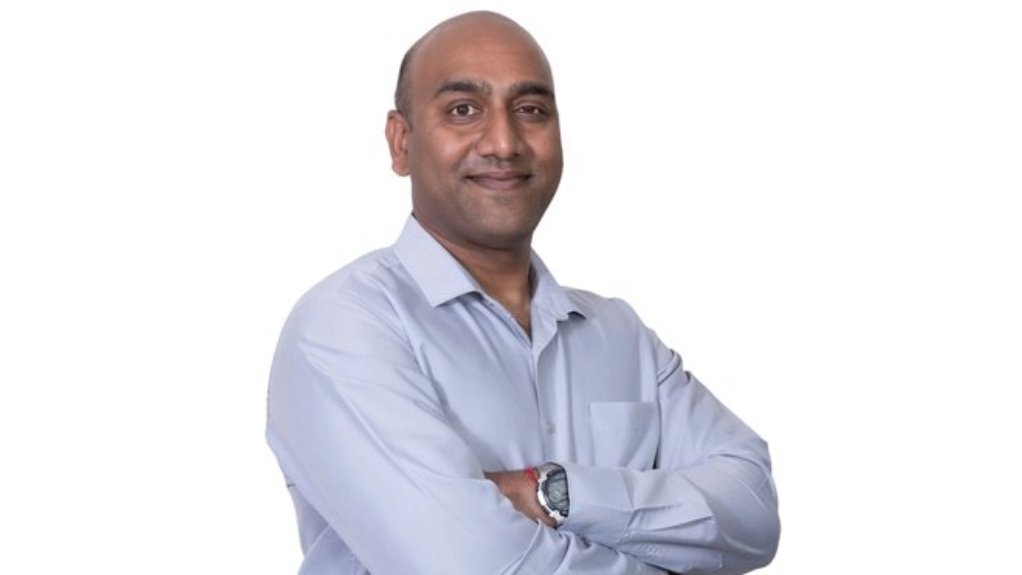Digitalisation can help bolster safety across mines and factories





Bolstering collaboration and leveraging digitalisation are key to reaching zero harm in the mining, industrial sectors
Dushendra Naidoo
Ingrid Osborne
While South Africa has made notable progress in reducing occupational injuries and diseases in the mining and industrial sectors, more needs to be done – including bolstering collaboration and leveraging digitalisation – to reach zero harm.
This was highlighted by speakers during the Health and Safety in Industry and Mining webinar hosted by Creamer Media earlier this month and facilitated by nonprofit organisation South African Institute of Occupational Safety and Health president Dr Sanjay Munnoo.
Eyes and ears were identified as the most commonly injured body parts of workers claiming compensation for occupational injuries and diseases in the South African mining and industrial sectors, said insurance company Rand Mutual Assurance compensation for occupational injuries and diseases prevention and operations head Dr Jessica Hutchings.
She added that noise-induced hearing loss continues to be one of the biggest occupational diseases in the mining and metals sector while eye injuries caused by foreign objects are particularly prevalent, especially in the metals space.
Hutchings also noted that wounds, sprains and strains to the hands, wrists, ankles and spine were also common, as the mining sector is still largely manually driven, despite ongoing modernisation and mechanisation efforts.
In the mining industry, respiratory conditions are also an issue, as are the repercussions of heat exposure.
The transport and machinery sector accounts for numerous fatalities, as well as fall-of-ground incidents, predominantly in the platinum and gold mining sectors, industry organisation Minerals Council South Africa safety and sustainable development head Dushendra Naidoo said.
However, he highlighted that the mining industry has made considerable progress in reducing the number of lives lost in the past few decades.
Although there were about 270 fatalities in the mining industry in 1993, compared to 55 at the end of 2023 – an 80% improvement – Naidoo stressed that there is still a long way to go to ensure that no lives are lost, thereby achieving the goal of zero harm.
Hutchings also stressed that organisations must shift the narrative from thinking of lives lost as mere numbers, as the impact was “far greater”, affecting not only individuals but also communities and dependants who lose their breadwinners.
Highlighting the recent incident in the George municipality, in the Western Cape, where a building collapsed, killing dozens of workers on site, industry body Consulting Engineers South Africa CEO Chris Campbell said this is symptomatic of a greater problem in the industry, with similar incidents occurring across the country and not receiving as much coverage.
More of these incidents need to be reported to address the root causes, while stakeholders on projects need to be properly educated on their roles and responsibilities. Additionally, there needs to be an adequate number of knowledgeable inspectors on projects to ensure that construction regulations are adhered to.
Campbell added that the organisation advocates for the proactive inclusion of health and safety professionals at the design stage of projects.
Tackling Safety Issues
Health and safety is such a broad, dynamic topic and, as a result, the drive towards zero harm requires a multidimensional, multifaceted approach; however, much can be done to streamline commonalities, Naidoo said.
Consequently, the speakers stressed the need for collaboration in industries and externally.
Hutchings emphasised that collaborative efforts among organisations need to be bolstered, noting that many are still working in silos in endeavouring to drive better health and safety.
Naidoo said that zero harm for the mining industry is achievable by applying lessons gleaned from other industries that have made strides in this regard, coupled with collaboration on common issues.
Highlighting the need for collaboration within the industry as well as with experts, given that mining is very intricate, with several facets specific to it, he added that mining has made strides in collaboration, with the Minerals Council facilitating this collaboration among companies, government and unions.
The Minerals Council South Africa Fall of Ground Action Plan is evidence of this, Naidoo averred.
This six-pillar plan, approved in 2021, is implemented in collaboration with professional mining organisations to address these incidents. The plan is supported by government, organised labour and suppliers.
Campbell also urged employers to be cognisant of, and proactive in, addressing employees’ mental health so that workers do not unknowingly put themselves at risk in the workplace, owing to stress, for example.
Hutchings said the importance of having a safety culture in an organisation must not be overlooked, highlighting that it must be led by top management. Naidoo reiterated this point, noting that behavioural culture requires continuous improvement.
“Very often, you can have all the technical safety requirements in place, but the culture is just not meeting the requirements, and incidents continue to happen.”
Campbell added that more is required to ensure effective enforcement of the country’s Occupational Health and Safety Act. He called for both a top-down and bottom-up approach, as well as proper knowledge and education, to assist in implementing and ensuring that “everyone is on board”.
While initiatives to tackle safety issues are having an impact, it will take time and effort to reach zero harm, said Naidoo. However, he cautioned that while this will be boosted by digitalisation, the introduction of technology brings its own complexities.
Digitalisation
AI and other advanced technologies can significantly improve occupational health and safety in the country through various applications, automation company Saryx Engineering co-founder and CEO Ingrid Osborne said.
AI algorithms analyse vast amounts of data for workplace systems and identify patterns and can predict potential hazards before they occur.
Machine learning models can be trained to recognise unsafe conditions and predict the likelihood of huge accidents based on historical data.
Internet-of-Things devices can be deployed across the workplace to continuously monitor environmental conditions, air quality, temperature and noise levels, among others.
Wearable technology can be integrated with critical sectors to monitor workers’ vital signs and provide real-time alerts for potential dangers, such as harmful gases and extreme temperature.
Osborne added that advances in virtual and augmented reality can be leveraged for immersive training programmes to simulate dangerous scenarios in a safe environment, thereby equipping workers to deal with emergencies and practice safe protocols without the real-world risk.
Instantaneous, streamlined reporting of safety instances and hazards provides opportunities to analyse and identity trends and, possibly, suggest preventative measures.
Further, automated documentation can help maintain and organise compliance documents to ensure that safety precools are followed, and that inspections are up to date and easily accessible during audits, Osborne added.
The benefits of implementing AI in this and other applications include enhanced regulatory compliance, a reduction in the risk of legal penalties and increased economic efficiency, owing to fewer costs associated with workplace accidents, she highlighted.
Most importantly, implementing AI will enhance employee confidence in the workplace and boost morale, thereby leading to better retention rates and increased ability to attract skilled labour.
Osborne also assured that implementation will not replace health and safety practitioners, but will serve as a tool to improve and augment their work: “I look at it as an essential tool. Digitalisation has to happen, and it’s proved to decrease incidents and accidents in the workplace.”
Hutchings added that digitalisation will help reduce the administrative load of health and safety practitioners.
Osborne advocated for all stakeholders in a workplace to participate in digital solutions, as this will provide an additional platform for transparency and drive better compliance across the board.
Companies’ adopting digitalisation and sharing health and safety information can drive healthy competition to be the most compliant company, she concluded.
Comments
Press Office
Announcements
What's On
Subscribe to improve your user experience...
Option 1 (equivalent of R125 a month):
Receive a weekly copy of Creamer Media's Engineering News & Mining Weekly magazine
(print copy for those in South Africa and e-magazine for those outside of South Africa)
Receive daily email newsletters
Access to full search results
Access archive of magazine back copies
Access to Projects in Progress
Access to ONE Research Report of your choice in PDF format
Option 2 (equivalent of R375 a month):
All benefits from Option 1
PLUS
Access to Creamer Media's Research Channel Africa for ALL Research Reports, in PDF format, on various industrial and mining sectors
including Electricity; Water; Energy Transition; Hydrogen; Roads, Rail and Ports; Coal; Gold; Platinum; Battery Metals; etc.
Already a subscriber?
Forgotten your password?
Receive weekly copy of Creamer Media's Engineering News & Mining Weekly magazine (print copy for those in South Africa and e-magazine for those outside of South Africa)
➕
Recieve daily email newsletters
➕
Access to full search results
➕
Access archive of magazine back copies
➕
Access to Projects in Progress
➕
Access to ONE Research Report of your choice in PDF format
RESEARCH CHANNEL AFRICA
R4500 (equivalent of R375 a month)
SUBSCRIBEAll benefits from Option 1
➕
Access to Creamer Media's Research Channel Africa for ALL Research Reports on various industrial and mining sectors, in PDF format, including on:
Electricity
➕
Water
➕
Energy Transition
➕
Hydrogen
➕
Roads, Rail and Ports
➕
Coal
➕
Gold
➕
Platinum
➕
Battery Metals
➕
etc.
Receive all benefits from Option 1 or Option 2 delivered to numerous people at your company
➕
Multiple User names and Passwords for simultaneous log-ins
➕
Intranet integration access to all in your organisation





















